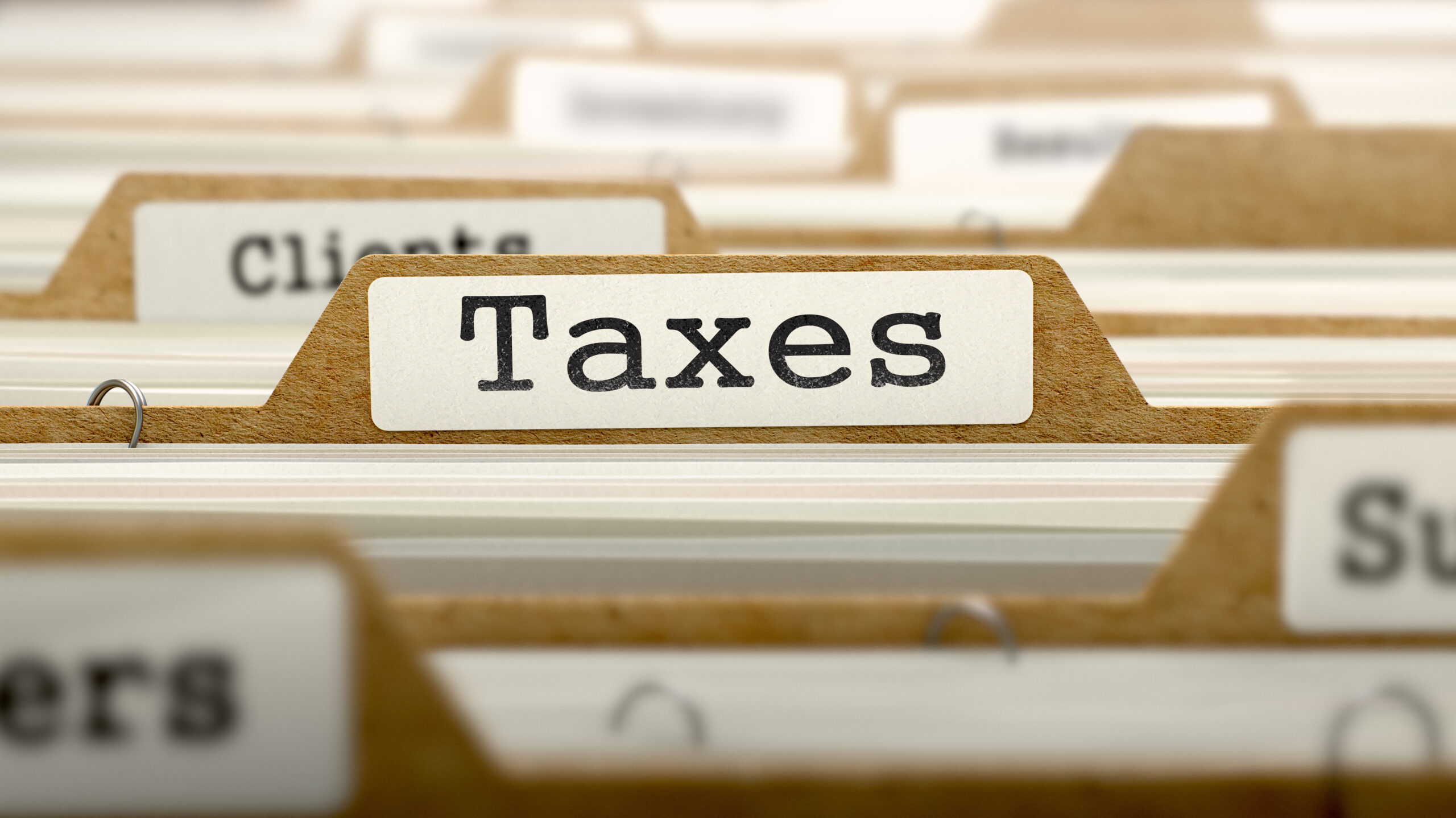Getting Ready for the 2022 Tax Filing Season
Filing your tax return promises to be just as complicated as always – especially if you received stimulus payments or advance child tax credit payments. However, there are steps that taxpayers can take right now to make sure their tax filing experience goes smoothly in 2022. Let’s take a look at four things taxpayers can do now to get ready for tax season:
Gather and Organize Tax Records
Organized tax records make preparing a complete and accurate tax return easier. They help avoid errors that lead to processing delays that slow refunds. Having all needed documents on hand before taxpayers prepare their return helps them file it completely and accurately. Important tax records you need to file a return include:
- Forms W-2 from employers
- Forms 1099 from banks, issuing agencies, and other payers, including unemployment compensation, dividends, distributions from a pension, annuity, or retirement plan
- Form 1099-K, 1099-MISC, W-2, or other income statements for workers in the gig economy
- Form 1099-INT for interest received
- Other income documents and records of virtual currency transactions
Taxpayers should also gather any documents from these types of earnings. People should keep copies of tax returns and all supporting documents for at least three years.
These types of Income documents help taxpayers determine if they’re eligible for deductions or credits. For example, people who need to reconcile their advance payments of the child tax credit and premium tax credit will need their related 2021 information. Those who did not receive their full third Economic Impact Payments will need their third payment amounts to figure and claim the 2021 recovery rebate credit.
Taxpayers should also keep end of year documents such as:
- Letter 6419, 2021 Total Advance Child Tax Credit Payments, to reconcile advance child tax credit payments
- Letter 6475, Your 2021 Economic Impact Payment, to determine eligibility to claim the recovery rebate credit
- Form 1095-A, Health Insurance Marketplace Statement, to reconcile advance premium tax credits for Marketplace coverage
Confirm Mailing and Email Addresses and Report Name Changes
To make sure forms make it to taxpayers on time, they should confirm now that each employer, bank, and other payer has their current mailing address or email address. People can report address changes by completing Form 8822, Change of Address and sending it to the IRS. Taxpayers should also notify the postal service to forward their mail online at USPS.com or their local post office. They should also notify the Social Security Administration of a legal name change.
View Account Information Online
Individuals who have not set up an Online Account yet should do so soon. People who have already set up an Online Account should make sure they can still log in successfully. Taxpayers can use Online Account to securely access the latest available information about their federal tax account.
Review Proper Tax Withholding and Make Adjustments if Needed
Taxpayers may want to consider adjusting their withholding if they find they owe taxes or receive a large refund in 2021. Changing withholding can help avoid a tax bill or let individuals keep more money each payday. Life changes – getting married or divorced, welcoming a child, or taking on a second job – may also be reasons to change withholding. Taxpayers might think about completing a new Form W-4, Employee’s Withholding Certificate, each year and when personal or financial situations change.
People also need to consider estimated tax payments. Individuals who receive a substantial amount of non-wage income like self-employment income, investment income, taxable Social Security benefits, and in some instances, pension and annuity income should make quarterly estimated tax payments. The last payment for 2021 is due on January 18, 2022.
Tax Season is Right Around the Corner
Filing taxes is inevitable for most people, and with tax law becoming more complex with every passing year, there’s no better time to get ready than right now. Call today and find out how a professional tax preparer can help.
Important Tax Changes for Individuals and Businesses
Every year, it’s a sure bet that there will be changes to current tax law, and this year is no different. From standard deductions to health savings accounts and tax rate schedules, here’s a checklist of tax changes to help you plan the year ahead.
Individuals
In 2022, a number of tax provisions are affected by inflation adjustments, including Health Savings Accounts, retirement contribution limits, and the foreign earned income exclusion. The tax rate structure, which ranges from 10 to 37 percent, remains similar to 2021; however, the tax-bracket thresholds increase for each filing status. Standard deductions also rise, and as a reminder, personal exemptions have been eliminated through tax year 2025.
Standard Deduction
In 2022, the standard deduction increases to $12,950 for individuals (up from $12,550 in 2021) and to $25,900 for married couples (up from $25,100 in 2021).
Alternative Minimum Tax (AMT)
In 2022, AMT exemption amounts increase to $75,900 for individuals (up from $73,600 in 2021) and $118,100 for married couples filing jointly (up from $114,600 in 2021). Also, the phaseout threshold increases to $539,900 ($1,079,800 for married filing jointly). Both the exemption and threshold amounts are indexed annually for inflation.
“Kiddie Tax”
For taxable years beginning in 2022, the amount that can be used to reduce the net unearned income reported on the child’s return that is subject to the “kiddie tax” is $1,150. The same $1,150 amount is used to determine whether a parent may elect to include a child’s gross income in the parent’s gross income and to calculate the “kiddie tax.” For example, one of the requirements for the parental election is that a child’s gross income for 2022 must be more than $1,150 but less than $11,500.
Health Savings Accounts (HSAs)
Contributions to a Health Savings Account (HSA) are used to pay the account owner’s current or future medical expenses, their spouse, and any qualified dependent. Medical expenses must not be reimbursable by insurance or other sources and do not qualify for the medical expense deduction on a federal income tax return.
A qualified individual must be covered by a High Deductible Health Plan (HDHP) and not be covered by other health insurance with the exception of insurance for accidents, disability, dental care, vision care, or long-term care.
For calendar year 2022, a qualifying HDHP must have a deductible of at least $1,400 for self-only coverage or $2,800 for family coverage and must limit annual out-of-pocket expenses of the beneficiary to $7,050 for self-only coverage and $14,100 for family coverage.
Medical Savings Accounts (MSAs)
There are two types of Medical Savings Accounts (MSAs): The Archer MSA created to help self-employed individuals and employees of certain small employers, and the Medicare Advantage MSA, which is also an Archer MSA, and is designated by Medicare to be used solely to pay the qualified medical expenses of the account holder. To be eligible for a Medicare Advantage MSA, you must be enrolled in Medicare. Both MSAs require that you are enrolled in a high-deductible health plan (HDHP).
Self-only coverage. For taxable years beginning in 2022, the term “high deductible health plan” for self-only coverage means a health plan that has an annual deductible that is not less than $2,450 and not more than $3,700, and under which the annual out-of-pocket expenses required to be paid (other than for premiums) for covered benefits do not exceed $4,950.
Family coverage. For taxable years beginning in 2022, the term “high deductible health plan” means, for family coverage, a health plan that has an annual deductible that is not less than $4,950 and not more than $7,400, and under which the annual out-of-pocket expenses required to be paid (other than for premiums) for covered benefits do not exceed $9,050.
AGI Limit for Deductible Medical Expenses
In 2022, the deduction threshold for deductible medical expenses is 7.5 percent of adjusted gross income (AGI), made permanent by the Consolidated Appropriations Act, 2021.
Eligible Long-Term Care Premiums
Premiums for long-term care are treated the same as health care premiums and are deductible on your taxes subject to certain limitations. For individuals age 40 or younger at the end of 2022, the limitation is $450. Persons more than 40 but not more than 50 can deduct $880. Those more than 50 but not more than 60 can deduct $1,690, while individuals more than 60 but not more than 70 can deduct $4,510. The maximum deduction is $5,640 and applies to anyone more than 70 years of age.
Medicare Taxes
The additional 0.9 percent Medicare tax on wages above $200,000 for individuals ($250,000 married filing jointly) remains in effect for 2022, as does the Medicare tax of 3.8 percent on investment (unearned) income for single taxpayers with modified adjusted gross income (AGI) more than $200,000 ($250,000 joint filers). Investment income includes dividends, interest, rents, royalties, gains from the disposition of property, and certain passive activity income. Estates, trusts, and self-employed individuals are all liable for the tax.
Foreign Earned Income Exclusion
For 2022, the foreign earned income exclusion amount is $112,000 up from $108,700 in 2021.
Long-Term Capital Gains and Dividends
In 2022, tax rates on capital gains and dividends remain the same as 2021 rates (0%, 15%, and a top rate of 20%); however, threshold amounts have increased: the maximum zero percent rate amounts are $41,675 for individuals and $83,350 for married filing jointly. For an individual taxpayer whose income is at or above $459,750 ($517,200 married filing jointly), the rate for both capital gains and dividends is capped at 20 percent. All other taxpayers fall into the 15 percent rate amount (i.e., above $41,675 and below $459,750 for single filers).
Estate and Gift Taxes
For an estate of any decedent during calendar year 2022, the basic exclusion amount is $12.06 million, indexed for inflation (up from $11.70 million in 2021). The maximum tax rate remains at 40 percent. The annual exclusion for gifts increases to $16,000.
Individuals – Tax Credits
Adoption Credit
In 2022, a nonrefundable (only those individuals with tax liability will benefit) credit of up to $14,890 is available for qualified adoption expenses for each eligible child.
Earned Income Tax Credit
For tax year 2022, the maximum Earned Income Tax Credit (EITC) for low, and moderate-income workers and working families increases to $6,935 (up from $6,728 in 2021). The credit varies by family size, filing status, and other factors, with the maximum credit going to joint filers with three or more qualifying children.
Child Tax Credit
For 2022, the child tax credit reverts to $2,000 per child, age 17 or younger. The refundable portion of the credit is $1,500 in 2022, so that even if taxpayers do not owe any tax, they can still claim the credit. A $500 nonrefundable credit is also available for dependents who do not qualify for the Child Tax Credit (e.g., dependents age 17 and older).
Child and Dependent Care Tax Credit
If you pay someone to take care of your dependent (defined as being under the age of 13 at the end of the tax year or incapable of self-care) to work or look for work, you may qualify for a credit of up to $1,050 or 35 percent of $3,000 of eligible expenses in 2022. For two or more qualifying dependents, you can claim up to 35 percent of $6,000 (or $2,100) of eligible expenses. For higher-income earners, the credit percentage is reduced, but not below 20 percent, regardless of the amount of adjusted gross income. This tax credit is nonrefundable.
Individuals – Education
American Opportunity Tax Credit and Lifetime Learning Credit
The maximum credit is $2,500 per student for the American Opportunity Tax Credit. The Lifetime Learning Credit remains at $2,000 per return. To claim the full credit for either, your modified adjusted gross income (MAGI) must be $80,000 or less ($160,000 or less for married filing jointly).
While the phaseout limits for Lifetime Learning Credit increased, taxpayers should note that the qualified tuition and expenses deduction was repealed starting in 2021.
Interest on Educational Loans
In 2022, the maximum deduction for interest paid on student loans is $2,500. The deduction begins to be phased out for higher-income taxpayers with modified adjusted gross income of more than $70,000 ($140,000 for joint filers) and is completely eliminated for taxpayers with modified adjusted gross income of $85,000 ($170,000 joint filers).
Individuals – Retirement
Contribution Limits
The elective deferral (contribution) limit for employees who participate in 401(k), 403(b), most 457 plans, and the federal government’s Thrift Savings Plan increases to $20,500. Contribution limits for SIMPLE plans also increase to $14,000. The maximum compensation used to determine contributions increases to $305,000 (up from $290,000 in 2021).
Income Phase-out Ranges
The deduction for taxpayers making contributions to a traditional IRA is phased out for singles and heads of household who are covered by an employer-sponsored retirement plan and have modified AGI between $68,000 and $78,000.
For married couples filing jointly, in which the spouse who makes the IRA contribution is covered by an employer-sponsored retirement plan, the phase-out range increases to $109,000 and $129,000. For an IRA contributor who is not covered by an employer-sponsored retirement plan and is married to someone who is covered, the deduction is phased out if the couple’s modified AGI is between $204,000 and $214,000.
The modified AGI phase-out range for taxpayers making contributions to a Roth IRA is $129,000 to $144,000 for singles and heads of household, up from $125,000 to $140,000. For married couples filing jointly, the income phase-out range is $204,000 to $214,000, up from $198,000 to $208,000. The phase-out range for a married individual filing a separate return who makes contributions to a Roth IRA is not subject to an annual cost-of-living adjustment and remains $0 to $10,000.
Saver’s Credit
In 2022, the AGI limit for the Saver’s Credit (also known as the Retirement Savings Contribution Credit) for low and moderate-income workers is $68,000 for married couples filing jointly, up from $66,000 in 2021; $51,000 for heads of household, up from $49,500 in 2021; and $34,000 for singles and married individuals filing separately, up from $33,000 in 2021.
Businesses
Standard Mileage Rates
In 2022, the rate for business miles driven is 58.5 cents per mile, up 2.5 cents from the rate for 2021.
Section 179 Expensing
In 2022, the Section 179 expense deduction increases to a maximum deduction of $1,080,000 of the first $2,700,000 of qualifying equipment placed in service during the current tax year. This amount is indexed to inflation for tax years after 2018. The deduction was enhanced under the TCJA to include improvements to nonresidential qualified real property such as roofs, fire protection, and alarm systems and security systems, and heating, ventilation, and air-conditioning systems. Also, of note is that costs associated with the purchase of any sport utility vehicle, treated as a Section 179 expense, cannot exceed $27,000.
Bonus Depreciation
Businesses are allowed to immediately deduct 100% of the cost of eligible property placed in service after September 27, 2017, and before January 1, 2023, after which it will be phased downward over a four-year period: 80% in 2023, 60% in 2024, 40% in 2025, 20% in 2026, and 0% in 2027 and years beyond.
Qualified Business Income Deduction
Eligible taxpayers are able to deduct up to 20 percent of certain business income from qualified domestic businesses, as well as certain dividends. To qualify for the deduction business income must not exceed a certain dollar amount. In 2022, these threshold amounts are $170,050 for single and head of household filers and $340,100 for married taxpayers filing joint returns.
Research & Development Tax Credit
Starting in 2018, businesses with less than $50 million in gross receipts can use this credit to offset alternative minimum tax. Certain start-up businesses that might not have any income tax liability will be able to offset payroll taxes with the credit as well.
Work Opportunity Tax Credit (WOTC)
Extended through 2025 (The Consolidated Appropriations Act, 2021), the Work Opportunity Tax Credit is available for employers who hire long-term unemployed individuals (unemployed for 27 weeks or more) and is generally equal to 40 percent of the first $6,000 of wages paid to a new hire.
Employee Health Insurance Expenses
For taxable years beginning in 2022, the dollar amount of average wages is $28,700 ($27,800 in 2021). This amount is used for limiting the small employer health insurance credit and for determining who is an eligible small employer for purposes of the credit.
Business Meals and Entertainment Expenses
Taxpayers who incur food and beverage expenses associated with operating a trade or business are able to deduct 100 percent (50 percent for tax years 2018-2020) of these expenses for tax years 2021 and 2022 (The Consolidated Appropriations Act, 2021) as long as the meal is provided by a restaurant.
Employer-provided Transportation Fringe Benefits
If you provide transportation fringe benefits to your employees in 2022, the maximum monthly limitation for transportation in a commuter highway vehicle as well as any transit pass is $280. The monthly limitation for qualified parking is $280.
While this checklist outlines important tax changes for 2022, additional changes in tax law are likely to arise during the year ahead. Don’t hesitate to call if you have any questions or want to get a head start on tax planning for the year ahead.
Tax Planning vs. Tax Preparation: What is the Difference?
Many people assume tax planning is the same as tax preparation, but the two are quite different. Let’s take a closer look:
What is Tax Preparation?
Tax preparation is the process of preparing and filing a tax return. Generally, it is a one-time event that culminates in signing your return and finding out whether you owe the IRS money or will be receiving a refund.
For most people, tax preparation involves one or two trips to your accountant (CPA), generally around tax time (i.e., between January and April), to hand over any financial documents necessary to prepare your return and then to sign your return. They will also make sure any tax reporting on your return complies with federal and state tax law.
Alternately, Individual taxpayers might use an enrolled agent, attorney, or a tax preparer who doesn’t necessarily have a professional credential. For simple returns, some individuals prepare tax returns themselves and file them with the IRS. No matter who prepares your tax return, however, you expect them to be trustworthy (you will be entrusting them with your personal financial details), skilled in tax preparation, and accurately file your income tax return in a timely manner.
What is Tax Planning?
Tax planning is a year-round process (as opposed to a seasonal event) and is a separate service from tax preparation. Both individuals and business owners can take advantage of tax planning services, which are typically performed by a CPA and accounting firm or an Enrolled Agent (EA) with in-depth experience and knowledge of tax law, rather than a tax preparer.
Examples of tax planning include the following: Bunching expenses (e.g., medical) to maximize deductions, tax-loss harvesting to offset investment gains, increasing retirement plan contributions to defer income, and determining the best timing for capital expenditures to reap the tax benefits. Good recordkeeping is also an important part of tax planning and makes it easier to pay quarterly estimated taxes, for example, or prepare tax returns the following year.
Tax planning is something that most taxpayers do not take advantage of – but should – because it can help minimize their tax liability on next year’s tax return by planning ahead. While it may mean spending more time with an accountant, say quarterly – or even monthly – the tax benefit is usually worth it. By reviewing past returns, an accountant will have a more clear picture of what you can do this year to save money on next year’s tax return.
If you’re ready to learn how a tax and accounting professional can help you save money on your tax bill this year, don’t hesitate to call the office today.
Reminder: Identity Protection PIN Available To Taxpayers
Starting in January 2021, the IRS Identity Protection PIN Opt-In Program expanded to include all taxpayers who can properly verify their identity. Previously, IP PINs were only available to identity theft victims.
What is an Identity Protection PIN?
An identity protection personal identification number (IP PIN) is a six-digit number assigned to eligible taxpayers to help prevent their Social Security number from being used to file fraudulent federal income tax returns. This number helps the IRS verify a taxpayer’s identity and accept their tax return. Taxpayers with either a Social Security Number or Individual Tax Identification Number who can verify their identity are eligible for the program, and the number is valid for one year. Each January, the taxpayer must get a new one.
How To Get an IP PIN
The preferred method of obtaining an IP PIN – and the only one that immediately reveals the PIN to the taxpayer – is the Get an IP PIN tool located on the IRS website. If someone is unable to pass the Secure Access authentication, there are two alternate ways to get an IP PIN.
Taxpayers with income of $72,000 or less should complete Form 15227, Application for an Identity Protection Personal Identification Number, and mail or fax it to the IRS. An IRS employee will call the taxpayer to verify their identity using a series of questions. Those who pass authentication will receive an IP PIN the following tax year.
Taxpayers who cannot verify their identities remotely or who are ineligible to file Form 15277 should make an appointment for in-person identity verification at an IRS Taxpayer Assistance Center and bring two forms of picture identification. After the taxpayer passes authentication, an IP PIN will be mailed to them within three weeks.
What Else Taxpayers Need To Know Before Applying:
- The IP PIN must be entered correctly on electronic and paper tax returns to avoid rejections and delays.
- Any primary or secondary taxpayer or dependent can get an IP PIN if they can prove their identity.
- Taxpayers who want to voluntarily opt into the IP PIN program don’t need to file a Form 14039, Identity Theft Affidavit.
- The IRS plans to offer an opt-out feature to the IP PIN program in 2022.
Confirmed Victims of Tax-related Identity Theft
For confirmed victims of tax-related identity theft, there is no change in the IP PIN Program. These taxpayers should still file a Form 14039, Identity Theft Affidavit if their e-filed tax return is rejected because of a duplicate SSN filing. The IRS will investigate their case, and once the fraudulent tax return is removed from their account, they will automatically receive an IP PIN by mail at the start of the next calendar year.
IP PINs will be mailed annually to confirmed victims and participants enrolled before 2019. For security reasons, confirmed identity theft victims can’t opt out of the IP PIN program. Confirmed victims also can use the IRS Get an IP PIN tool to retrieve lost IP PINs assigned to them.
As a reminder, taxpayers should never share their IP PIN with anyone but their tax provider. The IRS will never call to request the taxpayer’s IP PIN, and taxpayers must be alert to potential IP PIN scams. If you have any questions about the IP PIN, don’t hesitate to call.
Credit Reports: What You Should Know
Creditors keep their evaluation standards secret, making it difficult to know just how to improve your credit rating. Nonetheless, it is still important to understand the factors that determine creditworthiness. Periodically reviewing your credit report can also help you protect your credit rating from fraud – and you from identity theft.
Credit Evaluation Factors
Many factors are used in determining credit decisions. Here are some of them:
- Payment history/late payments
- Bankruptcy
- Charge-offs (Forgiven debt)
- Closed accounts and inactive accounts
- Recent loans
- Cosigning an account
- Credit limits
- Credit reports
- Debt/income ratios
- Mortgages
Obtaining Your Credit Reports
Credit reports are records of consumers’ bill-paying habits but do not include FICO credit scores. Also referred to as credit records, credit files, and credit histories, they are collected, stored, and sold by three credit bureaus, Experian, Equifax, and TransUnion.
The Fair Credit Reporting Act (FCRA) requires that each of the three credit bureaus provides you with a free copy of your credit report, at your request, every 12 months. If you have been denied credit or believe you’ve been denied employment or insurance because of your credit report, you can request that the credit bureau involved provide you with a free copy of your credit report – but you must request it within 60 days of receiving the notification.
You can check your credit report three times a year for free by requesting a credit report from a different agency every four months.
Fair Credit Reporting Act (FCRA)
The Fair Credit Reporting Act (FRCA) was passed in 1970 to give consumers easier access to and more information about their credit files. FCRA gives you the right to find out the information in your credit file, dispute information you believe is inaccurate or incomplete, and find out who has seen your credit report in the past six months.
Understanding Your Credit Report
Credit reports contain symbols and codes that are abstract to the average consumer. Every credit bureau report also includes a key that explains each code. Some of these keys decipher the information, but others cause more confusion.
Read your report carefully, making a note of anything you do not understand. The credit bureau is required by law to provide trained personnel to explain it to you. If accounts are identified by code number, or if there is a creditor listed on the report that you do not recognize, ask the credit bureau to supply you with the name and location of the creditor, so you can ascertain if you do indeed hold an account with that creditor.
If the report includes accounts that you do not believe are yours, it is extremely important to find out why they are listed on your report. It is possible they are the accounts of a relative or someone with a name similar to yours. Less likely, but more importantly, someone may have used your credit information to apply for credit in your name. This type of fraud can cause a great deal of damage to your credit report, so investigate the unknown account as thoroughly as possible.
In light of numerous credit card and other breaches, it is recommended that you conduct an annual review of your credit report. You must understand every piece of information on your credit report so that you can identify possible errors or omissions.
Disputing Errors
The Fair Credit Reporting Act (FCRA) protects consumers in the case of inaccurate or incomplete information in credit files. The FCRA requires credit bureaus to investigate and correct any errors in your file.
If you find any incorrect or incomplete information in your file, write to the credit bureau and ask them to investigate the information. Under the FCRA, they have about thirty days to contact the creditor and find out whether the information is correct. If not, it will be deleted.
Be aware that credit bureaus are not obligated to include all of your credit accounts in your report. If, for example, the credit union that holds your credit card account is not a paying subscriber of the credit bureau, the bureau is not obligated to add that reference to your file. Some may do so, however, for a small fee.
If you need help obtaining your credit reports or need assistance in understanding what your credit report means, don’t hesitate to call.
Standard Mileage Rates for 2022
Starting January 1, 2022, the standard mileage rates for the use of a car, van, pickup, or panel truck are as follows:
- 58.5 cents per mile driven for business use, up 2.5 cents from the rate for 2021
- 18 cents per mile driven for medical or moving purposes for qualified active-duty members of the Armed Forces, up 2 cents from the rate for 2021, and
- 14 cents per mile driven in service of charitable organizations. The charitable rate is set by statute and remains unchanged.
The standard mileage rate for business is based on an annual study of the fixed and variable costs of operating an automobile, including depreciation, insurance, repairs, tires, maintenance, gas, and oil. The rate for medical and moving purposes is based on the variable costs, such as gas and oil. The charitable rate is set by law.
Taxpayers always have the option of claiming deductions based on the actual costs of using a vehicle rather than the standard mileage rates.
Under the Tax Cuts and Jobs Act, taxpayers cannot claim a miscellaneous itemized deduction for unreimbursed employee travel expenses. Taxpayers also cannot claim a deduction for moving expenses, unless they are members of the Armed Forces on active duty moving under orders to a permanent change of station.
Taxpayers can use the standard mileage rate but must opt to use it in the first year the car is available for business use. Then, in later years, they can choose either the standard mileage rate or actual expenses.
Leased vehicles. Leased vehicles must use the standard mileage rate method for the entire lease period (including renewals) if the standard mileage rate is chosen.
If you have any questions about standard mileage rates or which driving activities you should keep track of as the new tax year begins, do not hesitate to contact the office.
Why Using the Correct Filing Status Matters
As taxpayers get ready for the upcoming filing season, one needs to know their correct filing status. A taxpayer’s filing status defines the type of tax return form they should use when filing their taxes. Filing status can affect the amount of tax they owe, and it may even determine if they have to file a tax return at all.
There are five IRS filing statuses. They generally depend on the taxpayer’s marital status as of Dec.31. However, more than one filing status may apply in certain situations. If this is the case, taxpayers can usually choose the filing status that allows them to pay the least amount of tax.
When preparing and filing a tax return, the filing status affects:
- If the taxpayer is required to file a federal tax return
- If they should file a return to receive a refund
- Their standard deduction amount
- If they can claim certain credits
- The amount of tax they should pay
Here are the five filing statuses:
- Single. Normally this status is for taxpayers who are unmarried, divorced or legally separated under a divorce or separate maintenance decree governed by state law.
- Married filing jointly. If a taxpayer is married, they can file a joint tax return with their spouse. When a spouse passes away, the widowed spouse can usually file a joint return for that year.
- Married filing separately. Married couples can choose to file separate tax returns. When doing so it may result in less tax owed than filing a joint tax return.
- Head of household. Unmarried taxpayers may be able to file using this status, but special rules apply. For example, the taxpayer must have paid more than half the cost of keeping up a home for themselves and a qualifying person living in the home for half the year.
- Qualifying widow(er) with dependent child. This status may apply to a taxpayer if their spouse died during one of the previous two years and they have a dependent child. Other conditions also apply.
Not sure which filing status you should use this year? Help is just a phone call away.
Tax Credits for Accommodating Disabled Workers
Businesses that make structural adaptations or other accommodations for employees or customers with disabilities may be eligible for tax credits and deductions. Let’s take a look at a few of the tax incentives that are available to encourage employers to hire qualified people with disabilities – and offset some of the costs of providing accommodations.
Disabled Access Credit
The disabled access credit is a non-refundable credit for small businesses that have expenses for providing access to persons with disabilities. An eligible small business earned $1 million or less or had no more than 30 full-time employees in the previous year.
The business can claim the credit each year they incur access expenditures. Eligible access expenditures must be reasonable and necessary to accomplish the following purposes and include amounts paid or incurred:
1. To remove barriers that prevent a business from being accessible to or usable by individuals with disabilities – but do not include expenditures paid or incurred in connection with any facility first placed in service after November 5, 1990;
2. To provide qualified interpreters or other methods of making audio materials available to deaf and hard of hearing individuals;
3. To provide qualified readers, taped texts, and other methods of making visual materials available to individuals with visual impairments; or
4. To acquire or modify equipment or devices for individuals with disabilities.
Barrier Removal Tax Deduction
The architectural barrier removal tax deduction encourages businesses of any size to remove architectural and transportation barriers to the mobility of people with disabilities and the elderly. Businesses may claim a deduction of up to $15,000 a year for qualified expenses on items that normally must be capitalized.
Businesses claim this deduction by listing it as a separate expense on their income tax return. Also, businesses may use the disabled tax credit and the architectural/transportation tax deduction together in the same tax year if the expenses meet the requirements of both sections. To use both, the deduction is equal to the difference between the total expenses and the amount of the credit claimed.
Work Opportunity Tax Credit
The work opportunity tax credit is available to employers for hiring individuals from certain target groups who have consistently faced significant barriers to employment. This includes people with disabilities and veterans.
The maximum amount of tax credit for employees who worked 400 or more hours of service is:
- $2,400 or 40% of up to $6,000 of first year wages, for qualifying individuals.
- $9,600 or 40% of up to $24,000 of first year wages for certain qualified veterans.
A 25% rate applies to wages for individuals who work at least 120 hours but less than 400 hours for the employer.
Don’t hesitate to contact the office with any questions about these and other small business tax credits.
Watch Out for Holiday Gift Card Scams
There’s never an off-season when it comes to scammers and thieves who want to trick people into scamming them out of money, stealing their personal information, or talking them into engaging in questionable behavior with their taxes. While scam attempts typically peak during tax season, taxpayers need to remain vigilant all year long. As such, it is once again time to remind taxpayers that while gift cards make great presents for loved ones, they cannot be used to pay taxes.
Nonetheless, that doesn’t stop scammers from targeting taxpayers by asking them to pay a fake tax bill with holiday gift cards. Scammers may also use a compromised email account to send emails requesting gift card purchases for friends, family, or co-workers.
How the Scam Works:
- The most common way scammers request gift cards is over the phone through a government impersonation scam. However, they will also request gift cards by sending a text message, email, or through social media.
- A scammer posing as an IRS agent will call the taxpayer or leave a voicemail with a callback number informing the taxpayer that they are linked to some criminal activity. For example, the scammer will tell the taxpayer their identity has been stolen and used to open fake bank accounts.
- The scammer will threaten or harass the taxpayer by telling them that they must pay a fictitious tax penalty.
- The scammer instructs the taxpayer to buy gift cards from various stores.
- Once the taxpayer buys the gift cards, the scammer will ask the taxpayer to provide the gift card number and PIN.
How to Know if it’s Really the IRS calling:
The IRS will never:
- Call to demand immediate payment using a specific payment method such as a gift card, prepaid debit card, or wire transfer. Generally, the IRS will first mail a bill to any taxpayer who owes taxes.
- Demand that taxpayers pay taxes without the opportunity to question or appeal the amount they owe. All taxpayers should be aware of their rights.
- Threaten to bring in local police, immigration officers, or other law enforcement to have the taxpayer arrested for not paying.
- Threaten to revoke the taxpayer’s driver’s license, business licenses or immigration status.
If You’ve Been Targeted by a Scammer:
- Contact the Treasury Inspector General for Tax Administration to report a phone scam. Use their IRS Impersonation Scam Reporting webpage. They can also call 800-366-4484.
- Report phone scams to the Federal Trade Commission. Use the FTC Complaint Assistant on FTC.gov. They should add “IRS phone scam” in the notes.
- Report threatening or harassing telephone calls claiming to be from the IRS to phishing@irs.gov. Please include “IRS phone scam” in the subject line.
What To Know About Keeping Good Tax Records
It’s January and tax season is right around the corner. For many people that means scrambling to collect receipts, mileage logs, and other tax-related documents needed to prepare their tax returns. If this describes you, chances are, you’re wishing you’d kept on top of it during the year so you could avoid this scenario yet again. With this in mind, here are seven suggestions to help taxpayers like you keep good records throughout the year:
1. Taxpayers should develop a system that keeps all their important info together. They can use a software program for electronic recordkeeping. They could also store paper documents in labeled folders.
2. Throughout the year, they should add tax records to their files as they receive them. Having records readily at hand makes preparing a tax return easier.
3. It may also help them discover potentially overlooked deductions or credits. Taxpayers should notify the IRS if their address changes. They should also notify the Social Security Administration of a legal name change to avoid a delay in processing their tax return.
4. Records that taxpayers should keep include receipts, canceled checks, and other documents that support income, a deduction, or a credit on a tax return.
5. Taxpayers should also keep records relating to property they dispose of or sell. They must keep these records to figure their basis for computing gain or loss.
6. In general, taxpayers should keep tax records for three years from the date they filed the return.
7. For business taxpayers, there’s no particular method of bookkeeping they must use. However, taxpayers should find a method that clearly and accurately reflects their gross income and expenses. The records should confirm income and expenses. Taxpayers who have employees must keep all employment tax records for at least four years after the tax is due or paid, whichever is later.
Well-organized records make it easier for taxpayers to prepare their tax returns. Good recordkeeping also helps provides answers in the event that a taxpayer’s return is selected for examination or if the taxpayer receives an IRS notice. If you need help setting up a recordkeeping system that works for you, don’t hesitate to call.
Start the New Year Right: Cleaning Up QuickBooks
January is always such a transitional month. You’re trying to wrap up everything that didn’t get done during a hectic December. At the same time, you have to jump into the new year and start doing your regularly-scheduled work. It can be hard to tell sometimes which year you’re working on.
Don’t forget about QuickBooks while you’re catching up on 2021 and looking ahead to 2022. You probably don’t want to put one more item on your to-do list, but any steps you take now to ready the software for the new year will pay off. Once you start entering transactions and placing orders, and welcoming new customers, it will help tremendously to have a clean slate.
Here are some suggestions for completing as much of the work you started in 2021 as you can:
Run Four Critical Reports
Bills can slip through without being paid in December because there’s so much going on and applies to both you and your customers. The best way to catch up on what’s owed to you (and what you owe) is to generate these four reports in QuickBooks:
- A/R Aging Detail. Which of your customers is in arrears with their payments to you? How much do they owe you, and when should the money have come in?
- Open Invoices. Which invoices have not yet been paid? There will be a certain amount of duplication with A/R Aging Detail, but this report isolates only unpaid transactions.
- A/P Aging Detail. Are you caught up with the money you owe other individuals and companies? This report will tell you.
- Unpaid Bill Details. Like Open Invoices, this report sets apart only the bills that have unpaid balances.
Create Statements for Past-due Customers

Figure 1: One collection method you can use in QuickBooks if you don’t want to communicate directly with overdue customers is to send statements.
You’ll have to decide how hard you want to lean on customers who are late paying your bills when it’s so early in the year. Certainly, if some customers are more than 60 days late (30 days if they have sizable balances), you may want to make a phone call or at least send a personalized email asking them to fulfill their obligations.
But you can also send statements. These documents provide details of financial activity between you and your customers for a given period of time. Open the Customers menu and click Create Statements. Look over all of the options in the window that opens and indicate your preferences. If customers don’t respond to your statements within ten days, it may be time for a phone call.
Take a Hard Look at Your Inventory
It may have been a while since you did this, but it’s imperative to do it regularly – especially if you had a busy holiday season. The best way to start on this is to open the Vendors menu, scroll down and hover over Vendor Activities, and click Inventory Center.
If you don’t have a lot of inventory, you could highlight each entry under Active Inventory, Assembly over to the left. The window that opens on the right side of the screen holds enormous detail about each item. But if you sell many different items, that will take too much time. In that case, you might run one or more of the reports linked from this screen. Even the QuickReport can be helpful.

Figure 2: You can get a lot of information about individual items you sell in QuickBooks’ Inventory Center.
Tip: If you need to adjust the quantity you have on hand, click the down arrow next to Manage Transactions in the lower left and select Adjust Quantity/Value on Hand. You might consult with us if you’re running into this problem, and we can go over inventory issues with you.
Set Up Online Financial Connections
January is also a good time to be thinking about how you can better use QuickBooks in 2022. We tend to learn how to use the tools we need and not explore any further when using software, and QuickBooks is such a large program that that’s understandable.
But two tools can have a tremendous impact on your daily workflow, your ability to get paid faster by customers and your understanding of where you stand financially every day. They are:
- Online Banking. Did you know that you can connect QuickBooks to many financial institutions and import your cleared daily transactions? That’s what the Bank Feeds Center is all about. If you sign up for this service, you won’t have to wait until your monthly statement comes to see what transactions have gone through.
- Online Payments. If you’re only accepting checks as payment from your customers, you’re probably getting paid more slowly than you might. Sign up for QuickBooks Desktop Payments, and you’ll be able to process credit cards, eChecks, and ACH payments.
As always, if you need help with anything discussed in this month’s column, don’t hesitate to call.
Upcoming Due Dates for January 2022
During January
All employers – Give your employees their copies of Form W-2 for 2021 by January 31, 2022. If an employee agreed to receive Form W-2 electronically, post it on a website accessible to the employee and notify the employee of the posting.
January 31
Employers – Give your employees their copies of Form W-2 for 2021. If an employee agreed to receive Form W-2 electronically, have it posted on a website and notify the employee of the posting. File Form W-3, Transmittal of Wage and Tax Statements, along with Copy A of all the Forms W-2 you issued for 2021.
Payers of nonemployee compensation – File Form 1099-NEC for nonemployee compensation paid in 2021.
Individuals – who must make estimated tax payments. If you did not pay your last installment of estimated tax by January 18, you may choose (but are not required) to file your income tax return (Form 1040 or Form 1040-SR) for 2021 by January 31. Filing your return and paying any tax due by January 31, 2022, prevents any penalty for late payment of the last installment. If you cannot file and pay your tax by January 31, file and pay your tax by April 18 (April 19 if you live in Maine or Massachusetts).
Employers – Federal unemployment tax. File Form 940 for 2021. If your undeposited tax is $500 or less, you can either pay it with your return or deposit it. If it is more than $500, you must deposit it. However, if you already deposited the tax for the year in full and on time, you have until February 10 to file the return.
Farm Employers – File Form 943 to report social security and Medicare taxes and withheld income tax for 2021. Deposit or pay any undeposited tax under the accuracy of deposit rules. If your tax liability is less than $2,500, you can pay it in full with a timely filed return. If you deposited the tax for the year in full and on time, you have until February 10 to file the return.
Certain Small Employers – File Form 944 to report Social Security and Medicare taxes and withheld income tax for 2021. Deposit or pay any undeposited tax under the accuracy of deposit rules. If your tax liability is $2,500 or more from 2021 but less than $2,500 for the fourth quarter, deposit any undeposited tax or pay it in full with a timely filed return. If you deposited the tax for the year timely, properly, and in full, you have until February 10 to file the return.
Employers – Social Security, Medicare, and withheld income tax. File Form 941 for the fourth quarter of 2021. Deposit any undeposited tax. If your tax liability is less than $2,500, you can pay it in full with a timely filed return. If you deposited the tax for the quarter in full and on time, you have until February 10 to file the return.
Employers – Nonpayroll taxes. File Form 945 to report income tax withheld for 2021 on all nonpayroll items, including backup withholding and withholding on pensions, annuities, IRAs, gambling winnings, and payments of Indian gaming profits to tribal members. Deposit any undeposited tax. If your tax liability is less than $2,500, you can pay it in full with a timely filed return. If you deposited the tax for the year in full and on time, you have until February 10 to file the return.
Payers of Gambling Winnings – If you either paid reportable gambling winnings or withheld income tax from gambling winnings, give the winners their copies of Form W-2G.
Businesses – Give annual information statements to recipients of certain payments made during 2021. You can use the appropriate version of Form 1099 or other information return. Form 1099 can be issued electronically with the consent of the recipient. This due date only applies to certain types of payments.
Any accounting, business or tax advice contained in this communication, including attachments and enclosures, is not intended as a thorough, in-depth analysis of specific issues, nor a substitute for a formal opinion, nor is it sufficient to avoid tax-related penalties. If desired, we would be pleased to perform the requisite research and provide you with a detailed written analysis. Such an engagement may be the subject of a separate engagement letter that would define the scope and limits of the desired consultation services.
































